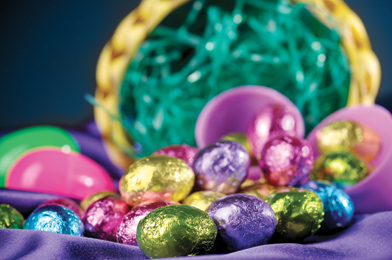Sweet Easter treats

By Nicole DaughheteeCourier Staff
I have an incredible sweet tooth and must admit that confectionary delicacies are certainly a treat I enjoy during the Easter season. Without a doubt, my favorite Easter candy is the Cadbury Crème Egg.
John Cadbury made his first “French eating Chocolate” in 1842, but it was not until 1875 that the first Cadbury Easter Eggs were made. Progress in the chocolate Easter egg market was slow until a method was found for making the chocolate flow into the molds.
The modern chocolate Easter egg owes its progression to the two greatest developments in the history of chocolate — the Dutch invention of a press for separating cocoa butter from the cocoa bean in 1828 and the introduction of a pure cocoa by Cadbury Brothers in 1866. The Cadbury process made large quantities of cocoa butter available, and this was the secret of making molded chocolate or indeed, any fine eating chocolate.
The earliest Cadbury chocolate eggs were made of “dark” chocolate with a plain smooth surface and were filled with sugared almonds. The earliest “decorated eggs” were plain shells enhanced by chocolate piping and marzipan flowers.
Decorative skill and variety bloomed, and by 1893 there were 19 different lines on the Cadbury Brothers’ Easter list in the UK. Richard Cadbury’s artistic skill undoubtedly played an important part in the development of the Easter range.
Many of his designs were based on French, Dutch and German originals adapted to Victorian tastes. Germany came up with the “crocodile” finish, which by breaking up the smooth surface, disguised minor imperfections. This was the forerunner to the many distinctive finishes now available.
The launch in 1905 of Cadbury’s Dairy Milk Chocolate made a tremendous contribution to the Easter egg market. The popularity of this new chocolate vastly increased sales of Easter eggs and establish them as seasonal best sellers. Today the Easter egg market is predominantly milk chocolate.
The Easter egg market is one of the most exciting confectionary markets, with new ranges and presentations attracting more consumers every year. The Easter Egg gift market reaches all ages of the population — young and old alike.
Although I am partial to chocolate, there are numerous other interesting facts related to Easter’s candy industry. Did you know that 90 million chocolate Easter bunnies are made for Easter each year? Or that the world’s largest jelly bean weighs more than 6,000 pounds?
Here are a few others:
When taking a bite into a chocolate bunny, 76 percent of Americans prefer to bite off the ears first. Five percent eat the feet first, and 4 percent eat the tail first.
During the Easter season, Americans buy more than 700 million Marshmallow Peeps, shaped like chicks, as well as Marshmallow Bunnies and Marshmallow Eggs, making them the most popular non-chocolate Easter candy.
As many as 5 million Marshmallow Peeps, bunnies, and other shapes are made each day in preparation for Easter.
In 1953, it took 27 hours to create a Marshmallow Peep. Today it takes six minutes.
Yellow Peeps are the most popular, followed by pink, lavender, blue, and white.
Adults prefer milk chocolate (65 percent) over dark chocolate (27 percent).
86 percent would prefer having chocolate bunnies instead of a live rabbit.
Each day throughout the year, 5 million marshmallow chicks and bunnies are produced in preparation for Easter.
16 billion jelly beans are made specifically for Easter which is enough to fill a plastic egg the size of a 9-story building.
Kids prefer red jelly beans and 75 percent are willing to do extra chores for more Easter candy.
57 percent of kids get up super early on Easter to see what the Easter bunny has brought them.
80 percent of parents carry on the tradition of the Easter bunny by preparing a surprise Easter basket filled with goodies for their children and 90 percent of adults hope for their own Easter treat.
The first chocolate eggs were made in Germany in the 19th century and remain one of the most popular Easter candies today.
Solid chocolate bunnies are favored, followed closely by hollow chocolate bunnies, marshmallow filled bunnies, and other Easter bunny candy.
In the old days pretzels were associated with Easter because the twists of the pretzel were thought to resemble arms crossing in prayer.
The exchange of eggs for Easter dates back to a springtime custom older than Easter itself in which eggs were given as a symbol of rebirth in many cultures.
After Halloween, Easter is the biggest candy consuming holiday of the year for Americans, who consumed 7 billion pounds of candy in 2011, according to the National Confectioner’s Association.
In 2012, Americans spent nearly $2.1 billion on Easter candy, while Halloween sales were more than $2 billion; Christmas, more than $1.4 billion; and Valentine’s Day, more than $1 billion.
Ninety million chocolate Easter bunnies are produced each year.
According to the Guinness Book of World Records, the largest Easter egg ever made was just more than 25 feet high and made of chocolate and marshmallow. The egg weighed 8,968 lbs. and was supported by an internal steel frame.
Candy makers are offering more and more Easter products. In the early 1980s, M&M’s became available in pastel spring colors. Reese’s makes peanut butter eggs, and Smucker’s produces jellybeans.
Some supermarkets have doubled the space allotted to Easter candy in the past few years as the market has increased.
Candy is a relatively recent Easter tradition. Chocolate eggs, the most popular Easter candy, were first made in Europe in the early 1800s.
Hot cross buns were among the earliest Easter treats, made by European monks and given to the poor during Lent.
Pretzels were originally associated with Easter. The twists of a pretzel were thought to resemble arms crossed in prayer.


























